Prevention of Falls from Heights in Construction Using an IoT System Based on Fuzzy Markup Language and JFML
Abstract
:1. Introduction
2. Background
2.1. FFH Management on Construction Site
2.2. Internet of Things
- Perception Layer: Integrates physical devices, such as sensors and actuators. They measure and obtain data and process the information associated with the state of cited devices. In addition, this layer transmits the information of the devices to the upper layers.
- Network Layer: Current layer receives the data from the perception layer and transmits them to the physical devices and applications.
- Application Layer: The information provided by the network layer is received by the application layer, and uses this information in the services and applications developed to work with such data.
2.3. IEEE Std 1855-2016 and JFML
3. IoT-JFML to FFH Proposal
- Altitude. Workplace height is an important variable in FFH. The consequences of FFH accidents are influenced by the altitude of the fall [61].
- Distance to the edge of the fall. A worker placed near to an edge at height is more likely to fall than another located far from the edge in the same workplace. In addition, when workers are placed on elevated surfaces heights, the related changes in their visual field, affect their body balance. There exists a direct relationship between fear of FFH and the actions performed for human postural control [62].
- BLE receiver (R);
- Harness (H) with BLE integrated for attachment detection ();
- Virtual barrier () of n BLE beacons (, , …, );
- Altimeter ();
- Anemometer ().
IOT-JFML Architecture to FFH
- Sensors provide data, which publish them into “input” topics. Then, the sensors should be related with their input variables. For instance, the sensor publishes data into the topic “input/Anm”. Similarly, the sensor publishes data into the topic “input/Alt”, etc.
- JFML is subscribed to all input topics to receive input data from the sensors and to assign them to the input variables. These input variables are defined in the FLS (represented in the FML file according to the IEEE std 1855-2016). For example, JFML is subscribed to the topics “input/Alt”, “input/Anm”, etc., to receive data from the sensors and , respectively. These sensors are associated with the input variables Altitude and Wind velocity, respectively.
- The inference is carried out once all of the sensors have published their information and JFML has assigned these values to the input variables. Rules are activated according to the input values and the rule base defined in the FML file.
- Once the inference process is finished, the output variables obtain values from the corresponding defuzzification method. Then, JFML publishes these values to “output” topics.
- Actuators receive data, so they are subscribed to “output” topics. As a result, they must be associated with output variables.
4. Case Study
4.1. Characterization of the Fuzzy Logic System
4.1.1. Determining the Knowledge Base
- Harness detection is associated with appropriate use of the hardness by the construction worker. The values of the input variable are: “Attached”, “Unattached”.
- Virtual fence distance depicts the average distance of the construction worker to the virtual barrier. Then, the input variable is composed of the fuzzy terms “Near”, “Medium”, and “Far” in the domain and expressed in centimeters.
- Altitude is defined as the related distance between the ground level and the worker. It is an input variable defined by the fuzzy terms “Little”, “Medium”, or “Tall” in the domain represented in meters.
- Wind velocity is the speed of the wind in the construction place. An input variable defined by the fuzzy terms “Low”, “Medium”, or “High” in the domain and represented in km/h.
- Risk represents the level of FFH risk. It is an output variable defined by the fuzzy terms “Low Risk”, “Medium Risk”, “High Risk”, and “Very High Risk” in the domain .
4.2. Determining the Rule Base
- 1.
- IF Virtual fence distance IS Far THEN Risk IS Low
- 2.
- IF Virtual fence distance IS Medium AND Harness detection IS attached THEN Risk IS Low…
- 4.
- IF Virtual fence distance IS Medium AND Harness detection IS unattached AND Altitude IS Little THEN Risk IS Low…
- 7.
- IF Virtual fence distance IS Near AND Wind velocity IS High THEN Risk IS Medium…
- 11.
- IF Wind velocity IS very High AND Altitude IS High THEN Risk IS Very High
4.3. Fuzzy Logic System According to the IEEE 1855-2016
4.4. Results from Different Construction Scenarios
4.4.1. Case 1: Working at Ground Level
4.4.2. Case 2: Formwork Activities
4.4.3. Case 3: Scaffolding Tasks
4.4.4. Case 4: Roofing Tasks
5. Conclusions
Author Contributions
Funding
Institutional Review Board Statement
Informed Consent Statement
Acknowledgments
Conflicts of Interest
References
- Choi, S.D.; Guo, L.; Kim, J.; Xiong, S. Comparison of fatal occupational injuries in construction industry in the United States, South Korea, and China. Int. J. Ind. Ergon. 2019, 71, 64–74. [Google Scholar] [CrossRef]
- Winge, S.; Albrechtsen, E.; Mostue, B.A. Causal factors and connections in construction accidents. Saf. Sci. 2019, 112, 130–141. [Google Scholar] [CrossRef]
- López Arquillos, A.; Rubio Romero, J.C.; Gibb, A. Analysis of construction accidents in Spain, 2003–2008. J. Saf. Res. 2012, 43, 381–388. [Google Scholar] [CrossRef] [PubMed] [Green Version]
- Zhang, J.; Zhang, W.; Xu, P.; Chen, N. Applicability of accident analysis methods to Chinese construction accidents. J. Saf. Res. 2019, 68, 187–196. [Google Scholar] [CrossRef]
- Allison, R.W.; Hon, C.K.; Xia, B. Construction accidents in Australia: Evaluating the true costs. Saf. Sci. 2019, 120, 886–896. [Google Scholar] [CrossRef]
- Rowlinson, S.; Yunyanjia, A.; Li, B.; Chuanjingju, C. Management of climatic heat stress risk in construction: A review of practices, methodologies, and future research. Accid. Anal. Prev. 2014, 66, 187–198. [Google Scholar] [CrossRef] [Green Version]
- Kang, K.; Ryu, H. Predicting types of occupational accidents at construction sites in Korea using random forest model. Saf. Sci. 2019, 120, 226–236. [Google Scholar] [CrossRef]
- Dong, X.S.; Largay, J.A.; Choi, S.D.; Wang, X.; Cain, C.T.; Romano, N. Fatal falls and PFAS use in the construction industry: Findings from the NIOSH FACE reports. Accid. Anal. Prev. 2017, 102, 136–143. [Google Scholar] [CrossRef] [Green Version]
- Suárez-Cebador, M.; Rubio-Romero, J.C.; López-Arquillos, A. Severity of electrical accidents in the construction industry in Spain. J. Saf. Res. 2014, 48, 63–70. [Google Scholar] [CrossRef]
- Choi, S.D. Aging workers and trade-related injuries in the US construction industry. Saf. Health Work. 2015, 6, 151–155. [Google Scholar] [CrossRef] [Green Version]
- Wu, W.; Yang, H.; Li, Q.; Chew, D. An integrated information management model for proactive prevention of struck-by-falling-object accidents on construction sites. Autom. Constr. 2013, 34, 67–74. [Google Scholar] [CrossRef] [Green Version]
- Nadhim, E.A.; Hon, C.; Xia, B.; Stewart, I.; Fang, D. Falls from height in the construction industry: A critical review of the scientific literature. Int. J. Environ. Res. Public Health 2016, 13, 638. [Google Scholar] [CrossRef] [PubMed] [Green Version]
- Umer, W.; Li, H.; Szeto, G.P.Y.; Wong, A.Y. Proactive safety measures: Quantifying the upright standing stability after sustained rebar tying postures. J. Constr. Eng. Manag. 2018, 144, 04018010. [Google Scholar] [CrossRef]
- Shi, Y.; Du, J.; Ahn, C.R.; Ragan, E. Impact assessment of reinforced learning methods on construction workers’ fall risk behavior using virtual reality. Autom. Constr. 2019, 104, 197–214. [Google Scholar] [CrossRef]
- Karakhan, A.A.; Gambatese, J.A. Integrating worker health and safety into sustainable design and construction: Designer and constructor perspectives. J. Constr. Eng. Manag. 2017, 143, 04017069. [Google Scholar] [CrossRef]
- Kang, Y.; Siddiqui, S.; Suk, S.J.; Chi, S.; Kim, C. Trends of fall accidents in the US construction industry. J. Constr. Eng. Manag. 2017, 143, 04017043. [Google Scholar] [CrossRef]
- Park, J.; Kim, K.; Cho, Y.K. Framework of automated construction-safety monitoring using cloud-enabled BIM and BLE mobile tracking sensors. J. Constr. Eng. Manag. 2017, 143, 05016019. [Google Scholar] [CrossRef]
- Awolusi, I.; Marks, E.; Hallowell, M. Wearable technology for personalized construction safety monitoring and trending: Review of applicable devices. Autom. Constr. 2018, 85, 96–106. [Google Scholar] [CrossRef]
- Gomez-de Gabriel, J.M.; Fernández-Madrigal, J.A.; Lopez-Arquillos, A.; Rubio-Romero, J.C. Monitoring harness use in construction with BLE beacons. Measurement 2019, 131, 329–340. [Google Scholar] [CrossRef]
- Patel, S.; Park, H.; Bonato, P.; Chan, L.; Rodgers, M. A review of wearable sensors and systems with application in rehabilitation. J. Neuroeng. Rehabil. 2012, 9, 1–17. [Google Scholar] [CrossRef] [Green Version]
- Aqueveque, P.; Gutierrez, C.; Rodríguez, F.S.; Pino, E.J.; Morales, A.S.; Wiechmann, E.P. Monitoring physiological variables of mining workers at high altitude. IEEE Trans. Ind. Appl. 2017, 53, 2628–2634. [Google Scholar] [CrossRef]
- Kabir, S.; Riyad, M.E.H.; Tanisha, U.T.; Bhuiyan, M.H.R.; Toha, T.R.; Alam, S.M.M. Automatic Fire Monitoring System in Textile Industry. In Proceedings of the 2020 11th International Conference on Electrical and Computer Engineering (ICECE), Dhaka, Bangladesh, 17–19 December 2020; IEEE: Piscataway, NJ, USA, 2020; pp. 471–474. [Google Scholar]
- Roberts, B.; Kardous, C.; Neitzel, R. Improving the accuracy of smart devices to measure noise exposure. J. Occup. Environ. Hyg. 2016, 13, 840–846. [Google Scholar] [CrossRef] [PubMed] [Green Version]
- Teizer, J.; Venugopal, M.; Walia, A. Ultrawideband for automated real-time three-dimensional location sensing for workforce, equipment, and material positioning and tracking. Transp. Res. Rec. 2008, 2081, 56–64. [Google Scholar] [CrossRef]
- Farkas, I.; Dukan, P.; Katona, J.; Kovari, A. Wireless sensor network protocol developed for microcontroller based Wireless Sensor units, and data processing with visualization by LabVIEW. In Proceedings of the 2014 IEEE 12th International Symposium on Applied Machine Intelligence and Informatics (SAMI), Herl’any, Slovakia, 23–25 January 2014; IEEE: Piscataway, NJ, USA, 2014; pp. 95–98. [Google Scholar]
- Liu, Z.; Liu, X.; Zhang, J.; Li, K. Opportunities and challenges of wireless human sensing for the smart IoT world: A survey. IEEE Netw. 2019, 33, 104–110. [Google Scholar] [CrossRef]
- Kovari, A.; Katona, J.; Costescu, C. Quantitative analysis of relationship between visual attention and eye-hand coordination. Acta Polytech. Hung 2020, 17, 77–95. [Google Scholar] [CrossRef]
- Kovari, A.; Katona, J.; Heldal, I.; Helgesen, C.; Costescu, C.; Rosan, A.; Hathazi, A.; Thill, S.; Demeter, R. Examination of gaze fixations recorded during the trail making test. In Proceedings of the 2019 10th IEEE International Conference on Cognitive Infocommunications (CogInfoCom), Naples, Italy, 23–25 October 2019; IEEE: Piscataway, NJ, USA, 2019; pp. 319–324. [Google Scholar]
- Maravić Čisar, S.; Pinter, R.; Kovári, A.; Pot, M. Application of Eye Movement Monitoring Technique in Teaching Process. IPSI Trans. Adv. Res. 2021, 17, 32–36. [Google Scholar]
- Katona, J.; Ujbanyi, T.; Sziladi, G.; Kovari, A. Examine the effect of different web-based media on human brain waves. In Proceedings of the 2017 8th IEEE International Conference on Cognitive Infocommunications (CogInfoCom), Debrecen, Hungary, 11–14 September 2017; IEEE: Piscataway, NJ, USA, 2017; pp. 407–412. [Google Scholar]
- Kovari, A. Study of Algorithmic Problem-Solving and Executive Function. Acta Polytech. Hung. 2020, 17, 241–256. [Google Scholar] [CrossRef]
- Hassan, Q. Internet of Things A to Z: Technologies and Applications; Wiley: Hoboken, NJ, USA, 2018. [Google Scholar]
- Guillaume, S. Designing fuzzy inference systems from data: An interpretability-oriented review. IEEE Trans. Fuzzy Syst. 2001, 9, 426–443. [Google Scholar] [CrossRef] [Green Version]
- Gürcanli, G.E.; Müngen, U. An occupational safety risk analysis method at construction sites using fuzzy sets. Int. J. Ind. Ergon. 2009, 39, 371–387. [Google Scholar] [CrossRef]
- Tadic, D.; Djapan, M.; Misita, M.; Stefanovic, M.; Milanovic, D.D. A fuzzy model for assessing risk of occupational safety in the processing industry. Int. J. Occup. Saf. Ergon. 2012, 18, 115–126. [Google Scholar] [CrossRef] [Green Version]
- Liu, H.T.; Tsai, Y.l. A fuzzy risk assessment approach for occupational hazards in the construction industry. Saf. Sci. 2012, 50, 1067–1078. [Google Scholar] [CrossRef]
- Amiri, M.; Ardeshir, A.; Zarandi, M.H.F. Fuzzy probabilistic expert system for occupational hazard assessment in construction. Saf. Sci. 2017, 93, 16–28. [Google Scholar] [CrossRef]
- Wong, T.K.M.; Man, S.S.; Chan, A.H.S. Critical factors for the use or non-use of personal protective equipment amongst construction workers. Saf. Sci. 2020, 126, 104663. [Google Scholar] [CrossRef]
- Izudi, J.; Ninsiima, V.; Alege, J.B. Use of personal protective equipment among building construction workers in Kampala, Uganda. J. Environ. Public Health 2017, 2017, 7930589. [Google Scholar] [CrossRef] [PubMed] [Green Version]
- Ayikoru, M.; Ddamulira, C.; Mutekanga, D.R. Determinants of employee use of personal protective equipment, the case of Spedag Interfreight Uganda limited, Kampala. J. Environ. Sci. Public Health 2019, 3, 419–434. [Google Scholar] [CrossRef] [Green Version]
- Singh, A.; Rehman, S.U.; Yongchareon, S.; Chong, P.H.J. Sensor technologies for fall detection systems: A review. IEEE Sens. J. 2020, 20, 6889–6919. [Google Scholar] [CrossRef]
- Fang, W.; Ding, L.; Luo, H.; Love, P.E. Falls from heights: A computer vision-based approach for safety harness detection. Autom. Constr. 2018, 91, 53–61. [Google Scholar] [CrossRef]
- Mao, A.; Ma, X.; He, Y.; Luo, J. Highly portable, sensor-based system for human fall monitoring. Sensors 2017, 17, 2096. [Google Scholar] [CrossRef] [Green Version]
- Rougier, C.; Meunier, J.; St-Arnaud, A.; Rousseau, J. Robust video surveillance for fall detection based on human shape deformation. IEEE Trans. Circuits Syst. Video Technol. 2011, 21, 611–622. [Google Scholar] [CrossRef]
- Bian, Z.P.; Hou, J.; Chau, L.P.; Magnenat-Thalmann, N. Fall detection based on body part tracking using a depth camera. IEEE J. Biomed. Health Inform. 2014, 19, 430–439. [Google Scholar] [CrossRef]
- Rimminen, H.; Lindström, J.; Sepponen, R. Positioning accuracy and multi-target separation with a human tracking system using near field imaging. Int. J. Smart Sens. Intell. Syst. 2017, 2. [Google Scholar] [CrossRef] [Green Version]
- Liu, L.; Popescu, M.; Skubic, M.; Rantz, M.; Yardibi, T.; Cuddihy, P. Automatic fall detection based on Doppler radar motion signature. In Proceedings of the 2011 5th International Conference on Pervasive Computing Technologies for Healthcare (PervasiveHealth) and Workshops, Dublin, Ireland, 23–26 May 2011; IEEE: Piscataway, NJ, USA, 2011; pp. 222–225. [Google Scholar]
- Ghosh, A.; Sanyal, A.; Chakraborty, A.; Sharma, P.K.; Saha, M.; Nandi, S.; Saha, S. On automatizing recognition of multiple human activities using ultrasonic sensor grid. In Proceedings of the 2017 9th International Conference on Communication Systems and Networks (COMSNETS), Bengaluru, India, 4–8 January 2017; IEEE: Piscataway, NJ, USA, 2017; pp. 488–491. [Google Scholar]
- Ozcan, K.; Velipasalar, S. Wearable camera-and accelerometer-based fall detection on portable devices. IEEE Embed. Syst. Lett. 2015, 8, 6–9. [Google Scholar] [CrossRef]
- Li, Y.; Ho, K.; Popescu, M. A microphone array system for automatic fall detection. IEEE Trans. Biomed. Eng. 2012, 59, 1291–1301. [Google Scholar] [PubMed]
- Rey-Merchán, M.d.C.; Gómez-de Gabriel, J.M.; Fernández-Madrigal, J.A.; López-Arquillos, A. Improving the prevention of fall from height on construction sites through the combination of technologies. Int. J. Occup. Saf. Ergon. 2020, 28, 590–599. [Google Scholar] [CrossRef]
- Valero, E.; Adán, A.; Cerrada, C. Evolution of RFID applications in construction: A literature review. Sensors 2015, 15, 15988–16008. [Google Scholar] [CrossRef] [Green Version]
- Lin, P.; Li, Q.; Fan, Q.; Gao, X. Real-time monitoring system for workers’ behaviour analysis on a large-dam construction site. Int. J. Distrib. Sens. Netw. 2013, 9, 509423. [Google Scholar] [CrossRef]
- Valero, E.; Adán, A. Integration of RFID with other technologies in construction. Measurement 2016, 94, 614–620. [Google Scholar] [CrossRef]
- MQTT Version 3.1.1. Edited by Andrew Banks and Rahul Gupta. 29 October 2014. OASIS Standard. Available online: http://docs.oasis-open.org/mqtt/mqtt/v3.1.1/os/mqtt-v3.1.1-os.html (accessed on 10 January 2022).
- IEEE Standard for Fuzzy Markup Language, Standard 1855-2016. 2016, pp. 1–89. Available online: https://standards.ieee.org/findstds/standard/1855-2016.html (accessed on 10 January 2022).
- Acampora, G.; Loia, V. Fuzzy control interoperability and scalability for adaptive domotic framework. IEEE Trans. Ind. Inform. 2005, 1, 97–111. [Google Scholar] [CrossRef]
- Ross, T.J. Fuzzy Logic with Engineering Applications, 4th ed.; John Wiley & Sons: Hoboken, NJ, USA, 2016. [Google Scholar]
- Angelov, P.; Yager, R. Simplified fuzzy rule-based systems using non-parametric antecedents and relative data density. In Proceedings of the IEEE Workshop on Evolving and Adaptive Intelligent Systems (EAIS), Paris, France, 11–15 April 2011; pp. 62–69. [Google Scholar] [CrossRef]
- Soto-Hidalgo, J.M.; Alonso, J.M.; Acampora, G.; Alcala-Fdez, J. JFML: A Java Library to Design Fuzzy Logic Systems According to the IEEE Std 1855-2016. IEEE Access 2018, 6, 54952–54964. [Google Scholar] [CrossRef]
- Alizo, G.; Sciarretta, J.; Gibson, S.; Muertos, K.; Romano, A.; Davis, J.; Pepe, A. Fall from heights: Does height really matter? Eur. J. Trauma Emerg. Surg. 2018, 44, 411–416. [Google Scholar] [CrossRef]
- Davis, J.R.; Campbell, A.D.; Adkin, A.L.; Carpenter, M.G. The relationship between fear of falling and human postural control. Gait Posture 2009, 29, 275–279. [Google Scholar] [CrossRef] [PubMed]
- Koehn, E.; Brown, G. Climatic effects on construction. J. Constr. Eng. Manag. 1985, 111, 129–137. [Google Scholar] [CrossRef]
- Rey-Merchán, M.d.C.; Gómez-de Gabriel, J.M.; López-Arquillos, A.; Fernández-Madrigal, J.A. Virtual fence system based on IoT paradigm to prevent occupational accidents in the construction sector. Int. J. Environ. Res. Public Health 2021, 18, 6839. [Google Scholar] [CrossRef] [PubMed]
- del Carmen Rey-Merchán, M.; Arquillos, A.L.; Soto-Hidalgo, J.M. A Fall from Height prevention proposal for construction sites based on Fuzzy Markup Language, JFML and IoT solutions. In Proceedings of the 2021 IEEE International Conference on Fuzzy Systems (FUZZ-IEEE), Luxembourg, 11–14 July 2021; IEEE: Piscataway, NJ, USA, 2021; pp. 1–6. [Google Scholar]
- Jahangiri, M.; Solukloei, H.R.J.; Kamalinia, M. A neuro-fuzzy risk prediction methodology for falling from scaffold. Saf. Sci. 2019, 117, 88–99. [Google Scholar] [CrossRef]
- Rodrigues, F.; Baptista, J.S.; Pinto, D. BIM Approach in Construction Safety—A Case Study on Preventing Falls from Height. Buildings 2022, 12, 73. [Google Scholar] [CrossRef]
- López-Arquillos, A.; Rubio-Romero, J.C.; Gibb, A.G.; Gambatese, J.A. Safety risk assessment for vertical concrete formwork activities in civil engineering construction. Work 2014, 49, 183–192. [Google Scholar] [CrossRef] [Green Version]
- Vigneshkumar, C.; Salve, U.R. A scientometric analysis and review of fall from height research in construction. Constr. Econ. Build. 2020, 20, 17–35. [Google Scholar]
- Hallowell, M.R.; Gambatese, J.A. Activity-based safety risk quantification for concrete formwork construction. J. Constr. Eng. Manag. 2009, 135, 990–998. [Google Scholar] [CrossRef]
- Yu, H.; Liu, F.; Wang, Y. Construction and Evaluation of Construction Safety Management System Based on BIM and Internet of Things. Secur. Commun. Netw. 2022, 2022, 1541241. [Google Scholar] [CrossRef]
- Brown, S.; Brooks, R.D.; Dong, X.S. New Trends of Fatal Falls in the Construction Industry; Springer: Berlin, Germany, 2020. [Google Scholar]
- Min, S.N.; Subramaniyam, M.; Park, S.J.; Lee, K.S. Development of the fall prevention index on the movable scaffold for construction workers. Work 2020, 65, 167–173. [Google Scholar] [CrossRef]
- Szóstak, M.; Hoła, B.; Bogusławski, P. Identification of accident scenarios involving scaffolding. Autom. Constr. 2021, 126, 103690. [Google Scholar] [CrossRef]
- Kang, Y. Use of fall protection in the US construction industry. J. Manag. Eng. 2018, 34, 04018045. [Google Scholar] [CrossRef]
- Khan, M.; Khalid, R.; Anjum, S.; Tran, S.V.T.; Park, C. Fall Prevention from Scaffolding Using Computer Vision and IoT-Based Monitoring. J. Constr. Eng. Manag. 2022, 148, 04022051. [Google Scholar] [CrossRef]
- Dong, X.S.; Wang, X.; Largay, J.A.; Platner, J.W.; Stafford, E.; Cain, C.T.; Choi, S.D. Fatal falls in the US residential construction industry. Am. J. Ind. Med. 2014, 57, 992–1000. [Google Scholar] [CrossRef] [PubMed]
- Dong, X.S.; Choi, S.D.; Borchardt, J.G.; Wang, X.; Largay, J.A. Fatal falls from roofs among US construction workers. J. Saf. Res. 2013, 44, 17–24. [Google Scholar] [CrossRef] [PubMed]
- Choi, S.d.; Griinke, D.; Lederer, M. Fall protection equipment effects on productivity and safety in residential roofing construction. J. Constr. Res. 2006, 7, 149–157. [Google Scholar] [CrossRef]
- Heidari, A.; Olbina, S.; Glick, S. Automated Positioning of Anchors for Personal Fall Arrest Systems for Steep-Sloped Roofs. Buildings 2021, 11, 10. [Google Scholar] [CrossRef]
- Sa, J.; Seo, D.C.; Choi, S.D. Comparison of risk factors for falls from height between commercial and residential roofers. J. Saf. Res. 2009, 40, 1–6. [Google Scholar] [CrossRef]
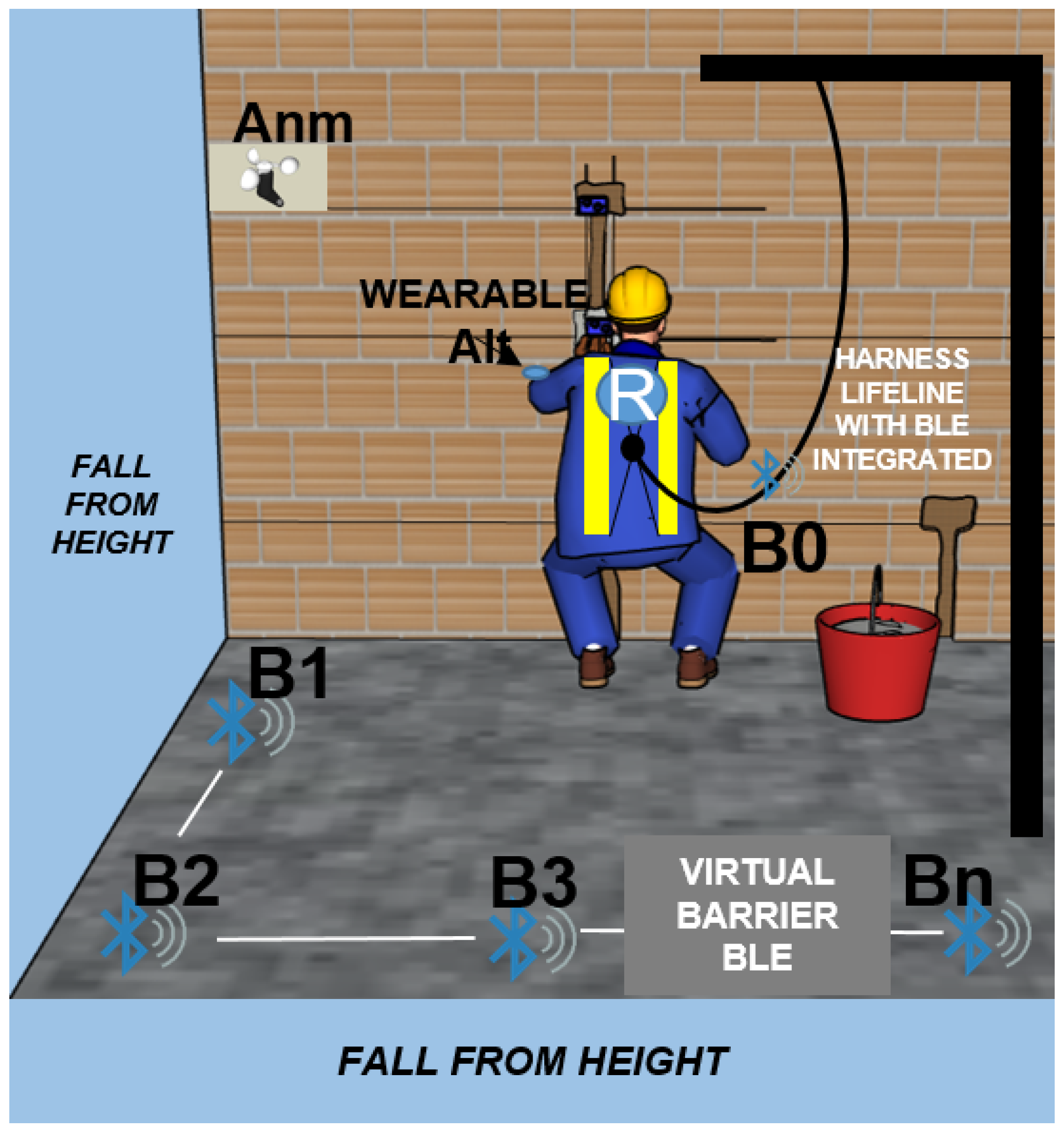




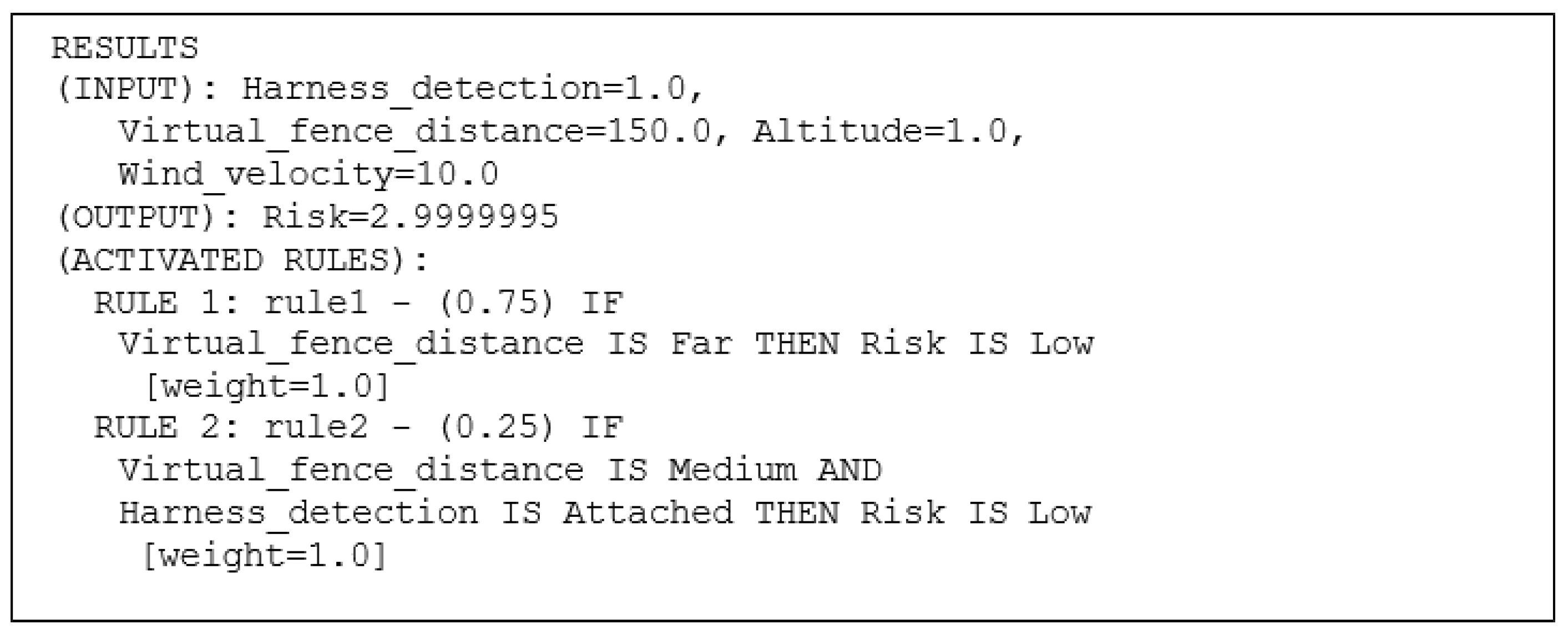


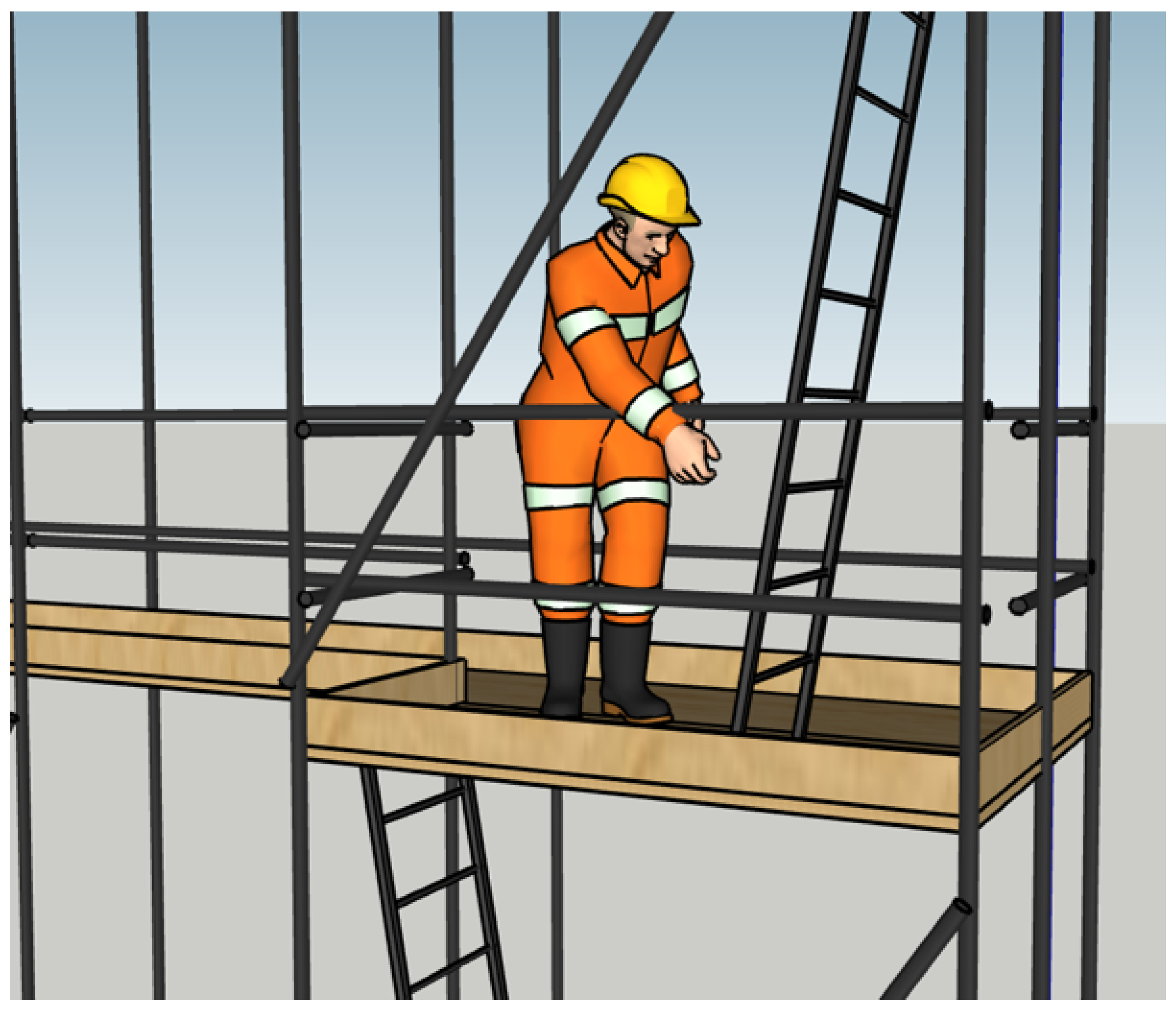

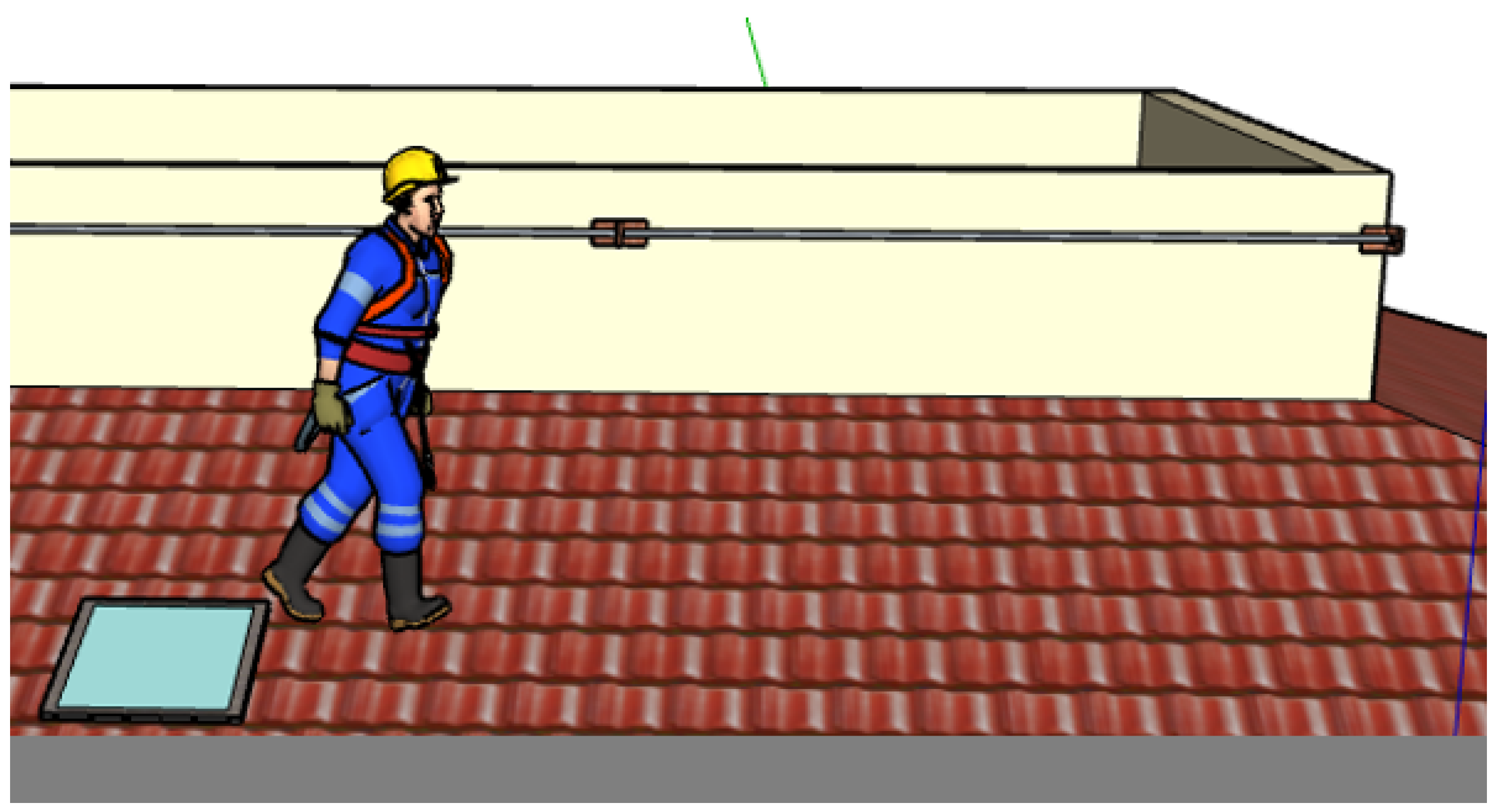
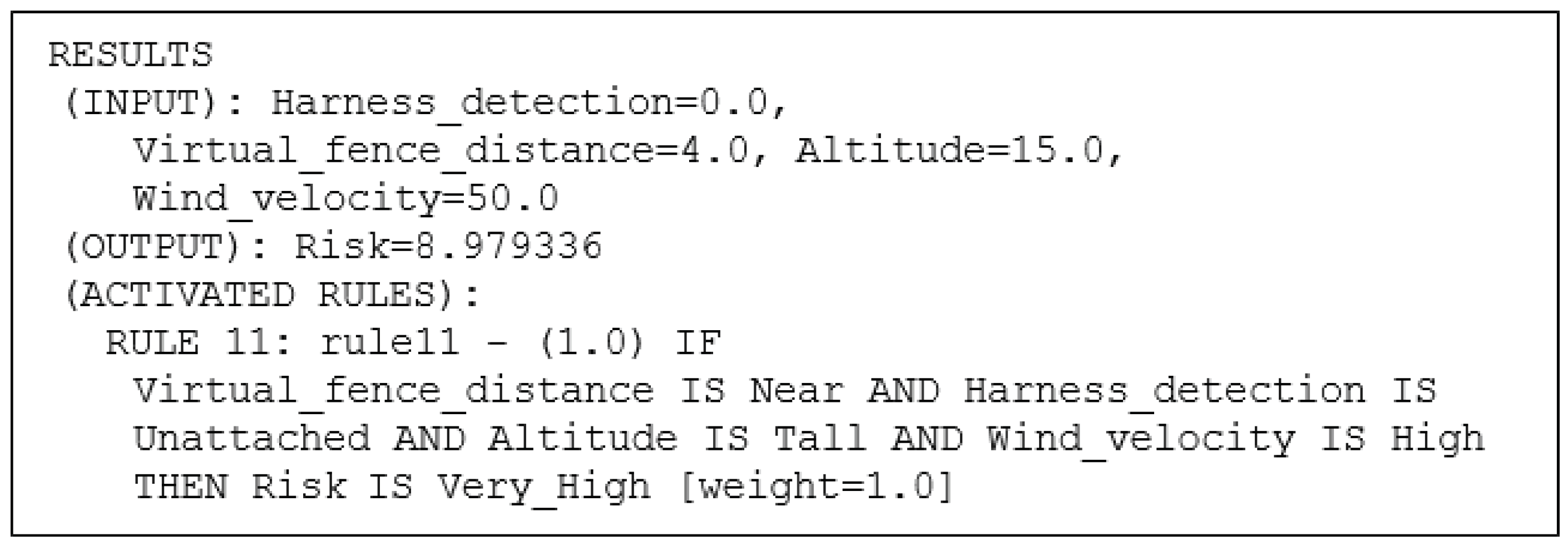
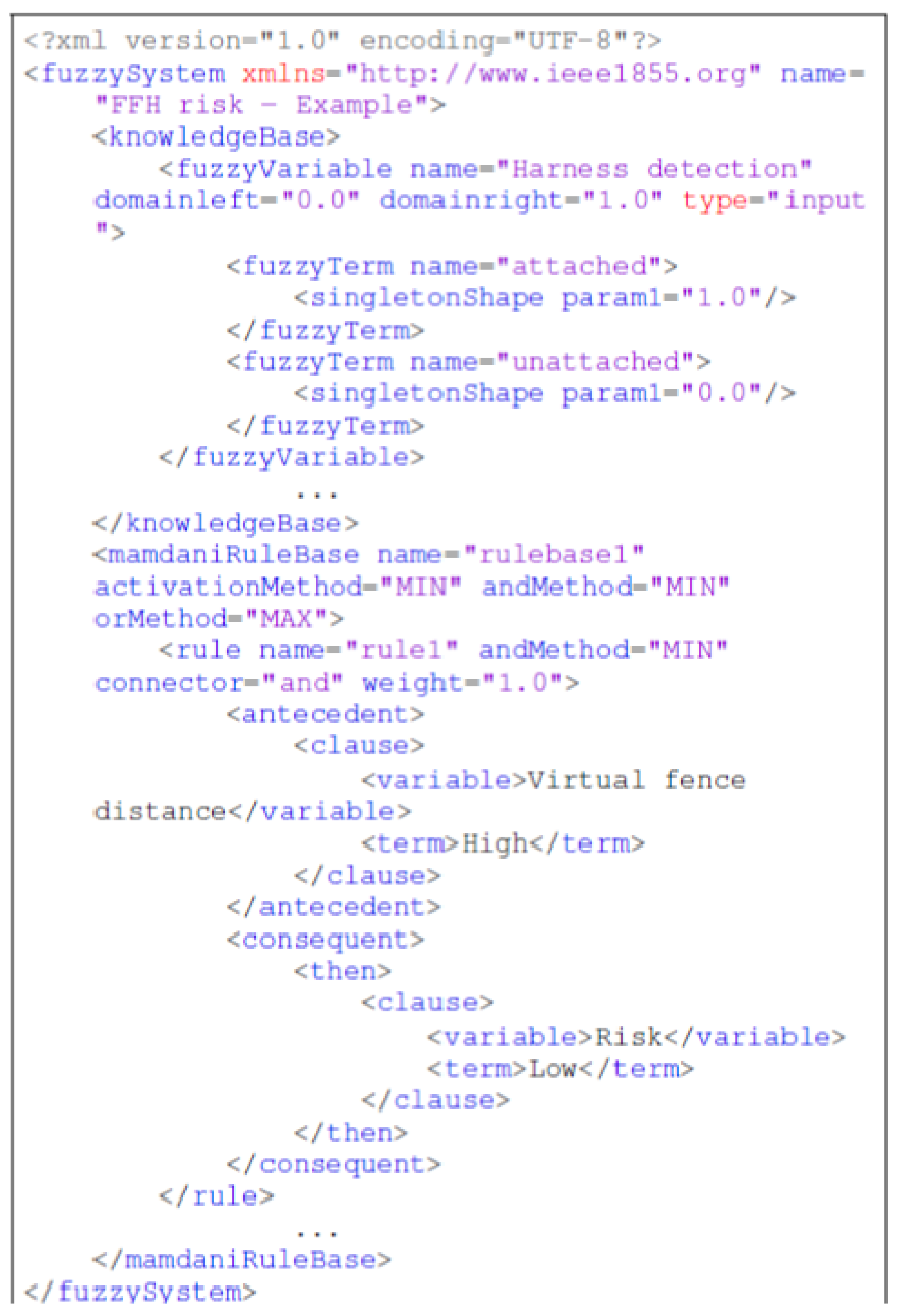
| Safety Hazard | Authors | Metric | Sensor |
|---|---|---|---|
| FFH | [19] | Proximity detection | BLE beacon |
| Slips | [20] | Body orientation, speed and postion | accelerometer |
| Extreme temperatures | [21] | Corporal temperature | Thermistor |
| Explosions and fire | [22] | Smoke and fire detection | WIFI |
| Noise | [23] | Noise level | Smartphone |
| Strucks | [11] | Distance detection system. | Radio Frequency |
| Electrocution | [24] | Proximity detection | UWB |
| Technology | Authors | Proposal | Signal |
|---|---|---|---|
| Wearable sensor | [19] | Monitoring use of Harness by workers | RSSI |
| Convolutional Neuronal Network | [42] | Detect safety harness wearing | Image |
| Smartphone sensor | [43] | An algorithm to detect falls based on the Euler angle and acceleration | Acceleration |
| RGB/IP Image Sensor | [44] | Analyzing human shape deformation during a video sequence | Image |
| Depth Image | [45] | Visualization of human joint analysis for falls detection | Image |
| Near Field Imaging sensor | [46] | The positioning accuracy is measured using raw observations | RFID |
| Radar sensor | [47] | Doppler radar-based fall detection system | Eco |
| Ultrasonic | [48] | Automated system for monitoring human activity using array of heterogeneous ultrasonic sensors | Ultrasounds |
| Hybrid | [49] | Fusing camera and accelerometer data | Images and aceleration |
| Sensor | Information | Range |
|---|---|---|
| BLE beacon () | RSSI | 0 to −94 dB |
| BLE Receiver (R) | Distances | 0 to 6 m |
| Altimeter () | Altitude | 0 to 200 m |
| Anemometer () | Wind velocity | 0 to 150 km/h |
| Variable | Low Risk | Medium Risk | High Risk |
|---|---|---|---|
| Detection of the Harness | attached | - | unattached |
| Distance to the Virtual fence | ≥150 cm | 150–50 cm | ≤50 cm |
| Altitude | 0–1 m | 1–2 m | ≤2 m |
| Wind velocity | ≥0–15 km/h | 16–30 km/h | ≤30 km/h |
Publisher’s Note: MDPI stays neutral with regard to jurisdictional claims in published maps and institutional affiliations. |
© 2022 by the authors. Licensee MDPI, Basel, Switzerland. This article is an open access article distributed under the terms and conditions of the Creative Commons Attribution (CC BY) license (https://creativecommons.org/licenses/by/4.0/).
Share and Cite
Rey-Merchán, M.d.C.; López-Arquillos, A.; Soto-Hidalgo, J.M. Prevention of Falls from Heights in Construction Using an IoT System Based on Fuzzy Markup Language and JFML. Appl. Sci. 2022, 12, 6057. https://doi.org/10.3390/app12126057
Rey-Merchán MdC, López-Arquillos A, Soto-Hidalgo JM. Prevention of Falls from Heights in Construction Using an IoT System Based on Fuzzy Markup Language and JFML. Applied Sciences. 2022; 12(12):6057. https://doi.org/10.3390/app12126057
Chicago/Turabian StyleRey-Merchán, María del Carmen, Antonio López-Arquillos, and José Manuel Soto-Hidalgo. 2022. "Prevention of Falls from Heights in Construction Using an IoT System Based on Fuzzy Markup Language and JFML" Applied Sciences 12, no. 12: 6057. https://doi.org/10.3390/app12126057
APA StyleRey-Merchán, M. d. C., López-Arquillos, A., & Soto-Hidalgo, J. M. (2022). Prevention of Falls from Heights in Construction Using an IoT System Based on Fuzzy Markup Language and JFML. Applied Sciences, 12(12), 6057. https://doi.org/10.3390/app12126057








